#I Ching
Explore tagged Tumblr posts
Text

mumei consults the I Ching
#mumei nanashi#hololive#i ching#han dynasty#fiddlesticks#get it she's fiddling with sticks (yarrow stalks) I AINT WASHED YET#def not what it looked like back then... i could only do 20 mins of research before bed#comic#wlart#williamleonard
2K notes
·
View notes
Text

Hexagram
© Manoel T, 2025
200 notes
·
View notes
Text
Japanese Magick
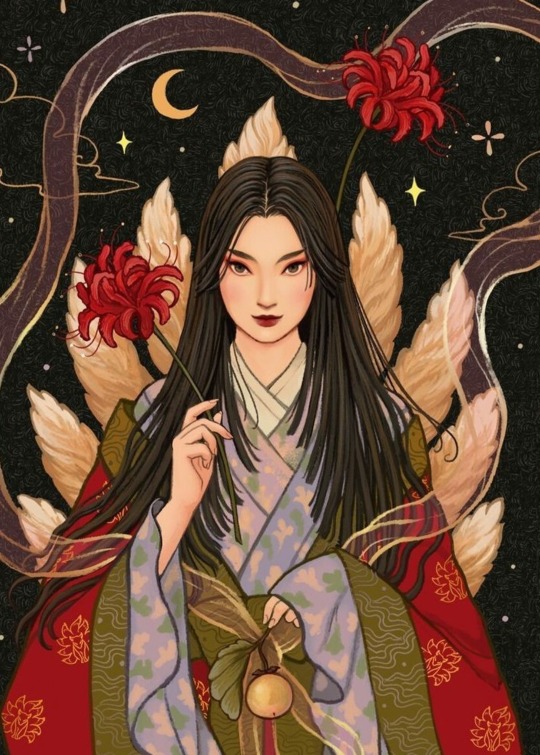
Japanese spirituality and folk magick are deeply rooted in Shinto, Buddhism, and indigenous traditions that blend animism, kami (spirits), and ritual practices. While Japan does not have a historical "witchcraft" tradition in the Western sense, it has a rich magickal heritage that includes onmyodo (esoteric cosmology), shugendo (mountain asceticism), folk magick, and spiritual practices passed down through generations.
So, let's explore the key elements of Japanese witchcraft and magick, including history, deities and spirits, traditional magickal practices, and how modern practitioners integrate these elements into their craft.
Foundations of Japanese Magick
🏮Shinto (神道) – The Way of the Kami
Shinto is the indigenous spiritual tradition of Japan, centered on reverence for kami (divine spirits) found in nature, ancestors, and sacred places. Many Japanese magickal practices stem from Shinto beliefs and rituals.
Key Concepts in Shinto Magick:
• Kami (神) – Spirits or deities that inhabit all things, including trees, mountains, rivers, and animals.
• Purification (禊 Misogi & 祓 Harai) – Cleansing oneself or a space of impurities before engaging in spiritual work.
• Offerings (供え物) – Giving food, incense, or prayers to kami and spirits to seek blessings or protection.
• Omamori (お守り) – Charms that provide luck, protection, and blessings.
🏮Onmyodo (陰陽道) – The Way of Yin-Yang
Onmyodo is an ancient system of esoteric cosmology and divination based on Taoist principles of yin-yang and the five elements. Practitioners, known as onmyōji (陰陽師), were skilled in astrology, geomancy, exorcism, and protective magick.

Onmyodo Magick Includes:
• Divination (卜占) – Fortune-telling using astrology, geomancy, or sacred texts.
• Talismans (護符 Gofu / Ofuda) – Paper or wooden charms inscribed with sacred symbols or prayers for protection.
• Spirit Banishing (鬼払い Oni-barai) – Rituals to remove negative spirits and influences.
• Elemental Magic (五行 Gogyō) – The Five Elements (Wood, Fire, Earth, Metal, Water) used for balance and spellwork.
🏮Shugendo (修験道) – Mountain Asceticism
Shugendo is a mystical tradition that blends Shinto, Buddhism, and Taoism. Its practitioners, known as yamabushi (山伏), are mountain monks who engage in spiritual endurance training, chanting, and nature-based magick.
Shugendo Magical Practices:
• Nature-Based Rituals – Using waterfalls, mountains, and caves for spiritual cleansing and empowerment.
• Firewalking (火渡り Hi-watari) – Walking over fire as a purification ritual.
• Mantra Chanting (真言 Shingon) – Reciting sacred phrases to invoke deities and spirits.
Key Deities and Spirits in Japanese Witchcraft
🏮Major Kami Associated with Magick:
• Inari Okami (稲荷大神) – Kami of prosperity, agriculture, and fox spirits (kitsune). Often invoked for abundance and transformation magick.
• Tsukuyomi (月読命) – Moon deity, associated with night magick, divination, and intuition.
• Ame-no-Uzume (天宇受売命) – Goddess of dawn, joy, and ritual dance. Invoked for creativity and uplifting energy.
• Raijin & Fujin (雷神・風神) – Thunder and wind gods, called upon for storm magick and elemental work.
• Susanoo-no-Mikoto (須佐之男命) – Kami of storms, exorcism, and warrior energy.

🏮Yokai (妖怪) & Spirit Beings:
Japanese folklore is filled with supernatural creatures, some of which play a role in magick:
• Kitsune (狐) – Fox spirits associated with transformation, illusion, and trickery.
• Tengu (天狗) – Mountain spirits and warriors with powerful knowledge of magick and martial arts.
• Yurei (幽霊) – Ghosts and ancestral spirits that may require appeasement or exorcism.
Traditional Japanese Magickal Practices
🏮Divination & Fortune-Telling:
• Omikuji (おみくじ) – Paper fortunes drawn at shrines to reveal one's luck.
• I Ching (易経 Ekikyō) – Taoist divination practice adopted in Japan.
• Tenmon (天文) – Japanese astrology, used by onmyōji for predicting fate and auspicious times.
🏮Talisman & Charm Magick:
• Omamori (お守り) – Protective charms bought from shrines, charged with blessings from kami.
• Ofuda (御札) – Paper talismans often hung in homes for protection.
• Shide (紙垂) – Zigzag-shaped paper strips used in purification and shrine rituals.
🏮Protection & Banishing Spells
• Salt Purification (塩清め Shio-kiyome) – Sprinkling salt around spaces to remove negativity.
• Oni-barai (鬼払い) – Banishing rituals to drive away malevolent spirits.
• Suzu (鈴) – Small bells used to ward off bad spirits.

🏮Elemental & Nature Magick
• Waterfall Purification (滝行 Takigyo) – Ritual bathing in waterfalls to cleanse the spirit.
• Moon Rituals (月の魔法 Tsuki no Maho) – Working with lunar phases for manifestation and divination.
• Kitsune Magick – Calling upon fox spirits for wisdom, transformation, and trickster energy.
Modern Japanese Witchcraft & Contemporary Practices
While Japan does not have a strong tradition of "witchcraft" as seen in the West, modern witches and spiritual practitioners integrate traditional elements into their craft.
🏮Ways to Practice Japanese-Inspired Magick Today:
• Shrine Visits – Offering prayers and petitions to kami.
• Japanese Herbal Magick – Using plants like mugwort (ヨモギ yomogi) for protection and cleansing.
• Tea Rituals – Preparing and blessing tea with intentions for peace, health, and wisdom.
• Shinto-Inspired Spellwork – Creating small home altars (kamidana) for divine guidance.
• Combining Onmyodo with Western Practices – Blending astrology, talisman magic, and elemental balancing with modern witchcraft.
Japanese magick is deeply connected to nature, spirits, and ancestral traditions. While Japan does not have a direct equivalent to Western witchcraft, its spiritual and folk practices offer rich ways to work with energy, divination, and protection magick. Whether you are drawn to Shinto nature worship, onmyodo divination, or spirit work with yokai, Japanese magickal traditions provide a fascinating and profound path for spiritual exploration.

#japan#japanese#japanese mythology#shinto#Kami#onmyodo#kitsune#Oni#tsukuyomi#witch#magick#witchcraft#demons#witchblr#witch community#eclectic witch#eclectic#pagan#spellwork#divination#protection magic#talisman#charms#spirit#nature spirits#exorcism#protection#i ching#culture#Religion
123 notes
·
View notes
Text

Henryk Waniek — Mountain Above, Fire Below (oil on canvas, 1987)
141 notes
·
View notes
Photo

Source details and larger version.
Knowing the future by supernatural means: vintage divination.
36 notes
·
View notes
Text
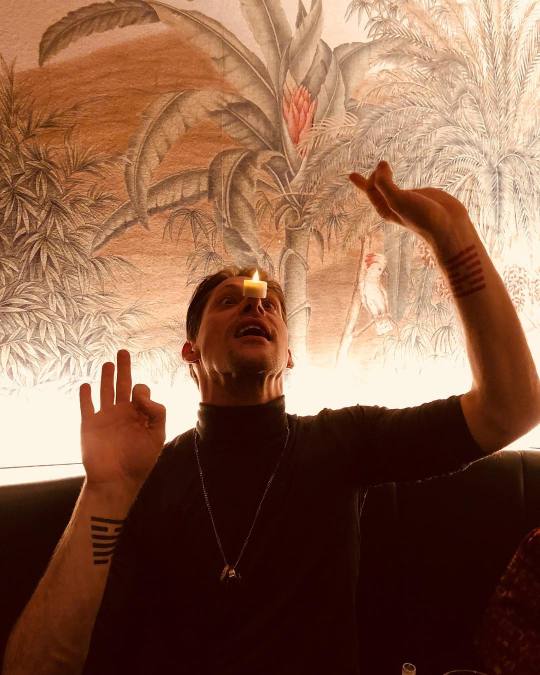
#neil newbon#s: instagram#goofball#nobigneil#vagabond#neilblr#keep it neil#no big neil#astarion voice actor#bg3#tattoos#men's fashion#light of my life#i ching
148 notes
·
View notes
Text
It’s what the I Ching would have been if conceived by Georges Bataille

“Throughout history, anomancy has had both its defenders and its detractors. In eras dominated by reason and logic, its principles were dismissed and ridiculed, yet it always retained a group of fervent followers who believed in the validity of its teachings. It is important to recognize that science and spirituality are not opposing forces but rather two sides of the same coin. While science seeks to explain the physical world's phenomena, anomancy explores the spiritual dimension of existence, providing answers to questions that reason alone cannot resolve.”
#anomancy#zhuang yunfei#divination#anatomy#china#chinese#bataille#georges bataille#i ching#book#science#spirituality#mysticism#reason
53 notes
·
View notes
Text

Today is a card of Heaven above and Water below. It’s named as Song and its meaning is dispute, to demand justice or to bring a case to the court. This card may be predicting to be vigilant today. An argument is likely to break out and spread like a wild fire getting many people involved in such a short matter of time. The advice is to do whatever you can to find common ground with the disputing parties so that the conflict doesn’t escalate further and become unstoppable.
#i ching#I Ching Cards#card reader#card reading#divination#fortune telling#fortune teller#message for the collective#gay pagan
41 notes
·
View notes
Text
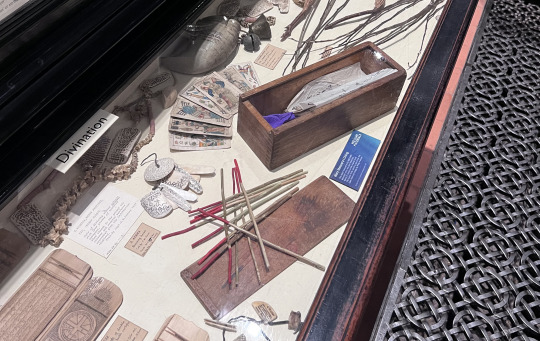
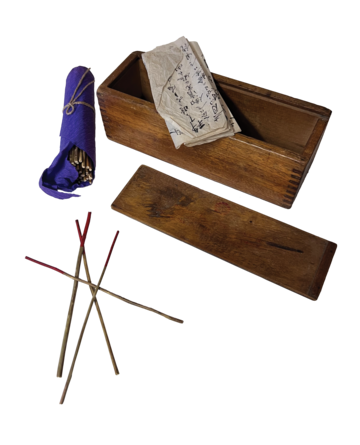
This object featured in the BBC/HBO television show His Dark Materials, Series 2, based on the original novel The Subtle Knife, which is part of the ‘His Dark Materials’ trilogy by Philip Pullman. The character Dr Mary Malone is a courageous visionary investigating how Dark Matter affects consciousness in our present day Oxford.
On loan from the production company, Bad Wolf.
You're telling me that when people consult the I Ching, they're getting in touch with Shadow-particles? With dark matter? The Subtle Knife by Philip Pullman
I Ching is an ancient Chinese divination text, used in a practice where bundles of yarrow sticks are used to produce numbers which are then interpreted.
To coincide with these film objects going on display, the museum is running schools sessions linked to His Dark Materials. These encourage students to reflect on the literary themes and characters in Philip Pullman's novels alongside usual interactions with the collections in the Museum and thinking about the many worlds represented through objects within the displays.
#i ching#the subtle knife#hdm#his dark materials#philip pullman#hdm hbo#hdm bbc#hdm tv#museum#pitt rivers museum#bad wolf#props#dr mary malone#mary malone#chinese#divination#literature#museum exhibit#oxford#dark matter
30 notes
·
View notes
Text
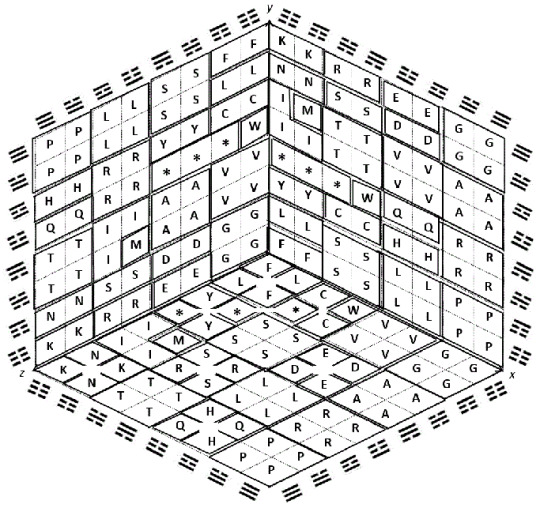
Castro-Chavez, Fernando. (2014). File Compression and Expansion of the Genetic Code by the Use of the Yin/Yang Directions to Find its Sphered Cube. Journal of biodiversity, bioprospecting and development. 1. 10.4172/2376-0214.1000112.
125 notes
·
View notes
Text
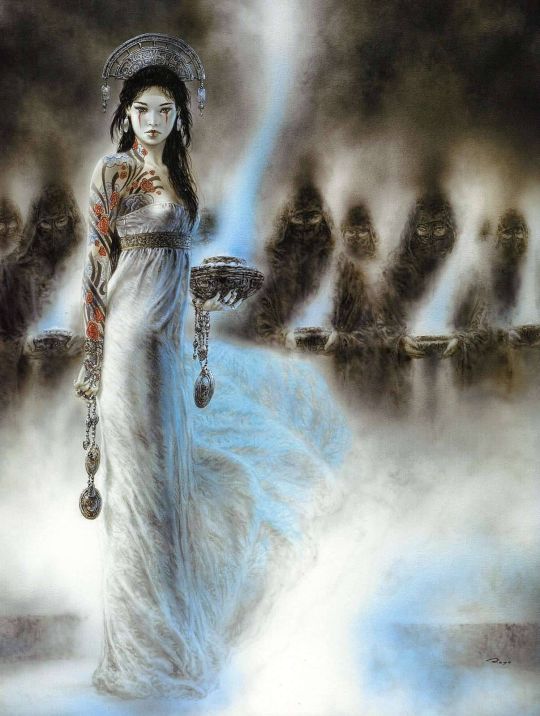
I Ching: Dead Moon by Luis Royo
46 notes
·
View notes
Text
The Tools That I Use In My I-Ching Practice

This is not a “how to,” just a little discussion on tools I use in my personal practice.
First, I should probably address why on earth a Western folk witch of European descent and a very European practice uses the I-Ching.
(Secondly, I should point out that you don’t need any of this shit, just three pennies and access to the internet will work. This is a practice I’ve grown into over a lot of years.)
Until I came across Eastern philosophy, I was a militant atheist. Growing up in the Baptist South will do that to a kid who is different. We didn’t go to church. Mom was raised Catholic, her grandmother had been a novice nun who wasn’t accepted into the monastic life because of how sickly she was (she never recovered mentally) and one of mom’s aunts was a nun. Dad was raised Lutheran (though the Moravian side of the family is Catholic). Neither family approved of the Catholic/Protestant intermarriage. Both are from the Midwest and I’m pretty sure neither has yet to grasp the concept of “being saved,” they certainly never introduced it to their kids.
I honestly don’t remember how on earth I started reading the Tao Te Ching, but the nature imagery really spoke to me. Worshipping nature was something I could wrap my head around.
Taoism is not a closed system and is “generally understood as a very open and flexible philosophy with diverse interpretations and practices, meaning it readily adapts and incorporates new ideas without strict boundaries or a centralized authority to enforce orthodoxy.”
It is rooted in animism and folk belief and was my gateway drug to philosophy, religion, animism, folk belief and so on. Before long, I wasn’t just collecting translations of the Tao Te Ching, but also the I-Ching. And from there all sorts of books of philosophy and religion.
When I encountered “the Wyrd” studying my own Anglo-Saxon culture and partial ancestry I couldn’t help but recognize something of the Tao.

The Oracle Deck
The Westerner in me just really wants to shuffle a deck.
This is my second deck after my first deck just didn’t work for me. The images were too concrete and static. In the current deck, the art by Joan Larrimore is more fluid, organic and open to many interpretations.

I-Ching Coins
The coins are the only gift I can remember my dad picking out for me, usually he leaves that up to mom. I like to think of these old Roman coins as changing hands all over Europe and as being a conduit to genetic and cultural ancestors. You aren’t typically supposed to clean old coins before using them in folk magic, but I did clean these up enough to discern heads from tails.
I use a bizarre system of cards and coins. With the Oracle cards you don’t get changing lines, which can be an important part of the reading. So, I developed my own personal system to incorporate the lines.

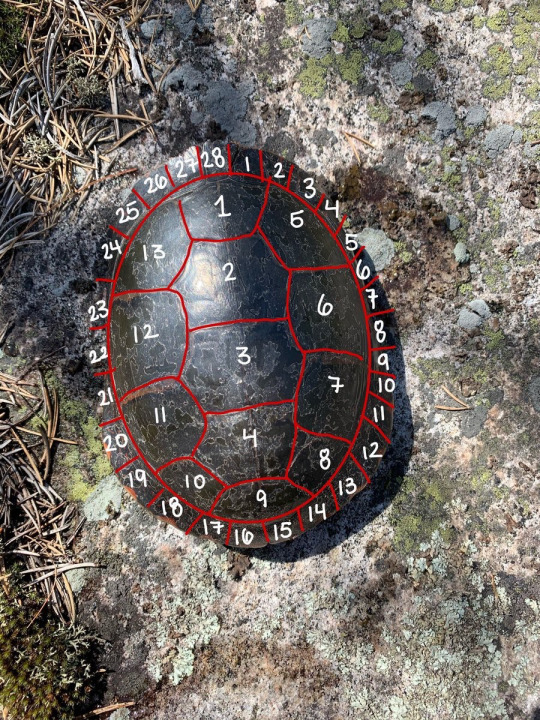
I-Ching Casting Bowl
You can cast the coins on any hard surface. I like to use this turtle shell as a casting bowl because there is a form of divination in China that uses turtle shells that both predates and is associated with the hexagrams.
Turtle shells are also associated with the lunar calendar—and the moon, of course, has its own ebb and flow of changing cycles.

I-Ching Card Wrap
One of the tools I use is a wrap that I embroidered using Elizabethan black work filler on THE Taoist symbol. Yin and yang, heaven and earth—the balance and motion between them is the basis of Taoism and of the I-Ching (and really fucking everything 😉).
Its purpose is to protect the cards both spiritually and psychically when not in use. In Chinese folk magic, the color red is a symbol of good fortune, happiness, and protection. It's also believed to ward off evil spirits and negative energy. I also use a piece of jade in the tie which is also used for the same purposes. The coin pendant is a representation of the year of the ox—the year in which I was born. I picked it up as a souvenir in the Chinese neighborhood in Philadelphia.

I-Ching Cloth
I embroidered the cloth that I use, copied from a “jaw-dropping work of embroidery [that]was done by Me Èè and Me Tchoupi, Tai Dam women in the town of Muang Sing.” @friend-crow
The original piece:

The Tai Dam are an ethnic minority group of people who are mainly from northwest Vietnam, China, Laos, and Thailand. The Tai Dam practice ethnic religions that mix Buddhism and folk animism. They believe in spirits that can be appeased to avoid curses and receive blessings. They also practice ancestor worship. Many Tai Dam people are shamanists who believe in unseen gods and demons.
The use of variegated thread shows movement and change and is what really spoke to me in this piece and made me want to use it in my I-Ching practice—it is the Book of Changes after all.
Many people use a tarot cloth to protect their cards from wear and tear on a hard surface—for me it is as much to set a mood.

Sage and Lavender Candle
Speaking of setting the mood—I love me some aromatherapy. Sage and Lavender both promote calmness and mental and spiritual clarity.

Hag Stone
“Many believe that the hole [in the stone] is a gateway into the world of spirits and Little People. Medicinal broths and brews can be poured through the hole and the medicine will pick up blessing from the other world as it passes through.”
—Brandon Weston, Ozark Folk Magic: Plants, Prayers & Healing
I blow breaths through the hole onto the cards and coins before I use them to forge a connection between myself, the otherworld, and the cards and coins.
————
Again, these are just ways I add depth to my practice, if you are interested in the I-Ching you can get started with a few pennies and the internet.
#i ching#taoism#oracle cards#devotional embroidery#turtle shell#Roman coins#hag stone#jade#lunar calendar#Chinese calendar#tai dam embroidery
32 notes
·
View notes
Text
I've been thinking for a while about the hexagrams Qian and Kun: pure yang and pure yin. It seemed to me that according to the principle of yin and yang that governs the I Ching, it shouldn't be possible for a Kun Medicine Seller to do much of anything unless acting alongside a Qian Medicine Seller. Yin is passive receptivity, and without yang, it has nothing to receive.
Alfred Huang's well-reputed interpretation of the I Ching says this about hexagram Kun:
"According to its nature, Kun can neither create nor develop. Although it has the potential, it cannot accomplish anything alone. Its accomplishment requires acceptance of the purest yang energy from Qian and action in accordance with perfect timing."
If the second Medicine Seller is the hexagram Kun, it seems that he would need to be acting alongside another Medicine Seller, the hexagram Qian.
I've suggested before that this Medicine Seller could actually be a hexagram made up of the Kun and Qian Trigrams and that this might explain his combined yin-yang traits. But now I'm thinking in a slightly different direction: Maybe the Medicine Sellers aren't meant to embody the hexagrams as static phenomena. Maybe they're actually meant to represent the movement from one hexagram to the other. The Medicine Sellers could be the agents of that movement and their swords the tools by which they accomplish it.
In terms of what the I Ching hexagrams symbolize, I think this makes sense: They don't represent static states but a series of changes that lead from one set of circumstances to another. And the Medicine Sellers are agents of change: Their actions influence the minds, lives, and futures of the people around them. Their swords are the tools by which they accomplish the greatest changes.
By this interpretation, each of the 64 swords is nothing more than a hexagram's ultimate mechanism of action for traversing the path into the next state. The Eight Trigram swords, representing the powerful cosmic forces that make up each one, would be the strongest mechanisms, with the other fifty-six swords being the actions of more ordinary change.
So, if the Medicine Sellers represent the movement of a hexagram, the second Medicine Seller might be said to represent neither the Qian nor Kun hexagram alone, but rather the movement from Qian to Kun. His yang traits carry over from the Qian hexagram, and he's given the sword of the Kun Trigram to create a connection between Qian and Kun that leads to the emergence of the Kun hexagram, whose function is to receive Qian.
(Whether this is consistent with the theory that he's a Qian-Kun hexagram, I'm not sure. Given how the hexagrams flow into each other, maybe hexagrams 11 and 12 could appear as between-states as hexagrams 1 and 2 flow into each other. Frankly, I don't understand the I Ching well enough to know what I'm talking about.)
In any case, I think this is an interesting possibility for interpreting what exactly the Medicine Sellers and their swords are. It makes some sense of a few points in the lore that have been bothering me. If the question of "which hexagrams the Medicine Sellers are" is more complicated than it appears, it would explain why it's never really addressed and why only their swords seem to be the basis of their stories and the symbolism around them.
26 notes
·
View notes
Text

Sheila Eaton Isham (1927-2024) —"Lu"- Fire with Mountain [acrylic on canvas, 1971]
106 notes
·
View notes
Text
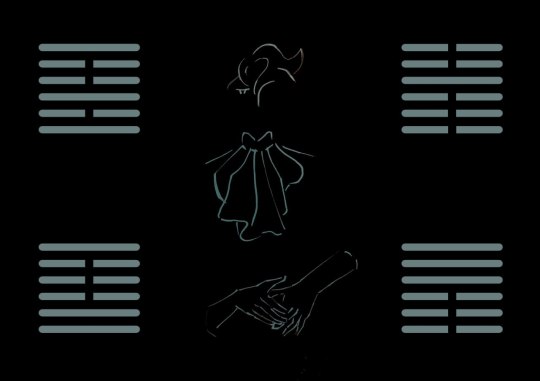

-- Let's do a divination, àirén
headcanon: Ivan sometimes calls Till with petnames of long dead languages (let's imagine that Chinese culture is destroyed by aliens), so only Ivan will understand, he will never dare to uncover the meaning behind it. a little liberty. (it's possible since Ivan had access to human books, he knew about religion, so he might have known about other aspects of culture.)
#artists on tumblr#artwork#art#illustration#colored sketch#sketch#alien stage#ivantill#i ching#alnst till#alnst ivan#alnst
30 notes
·
View notes
